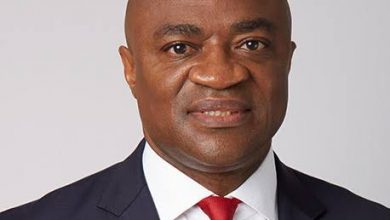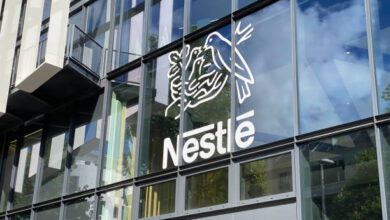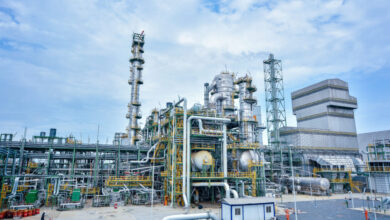FBNH: When the Profit Engine is Obsolete
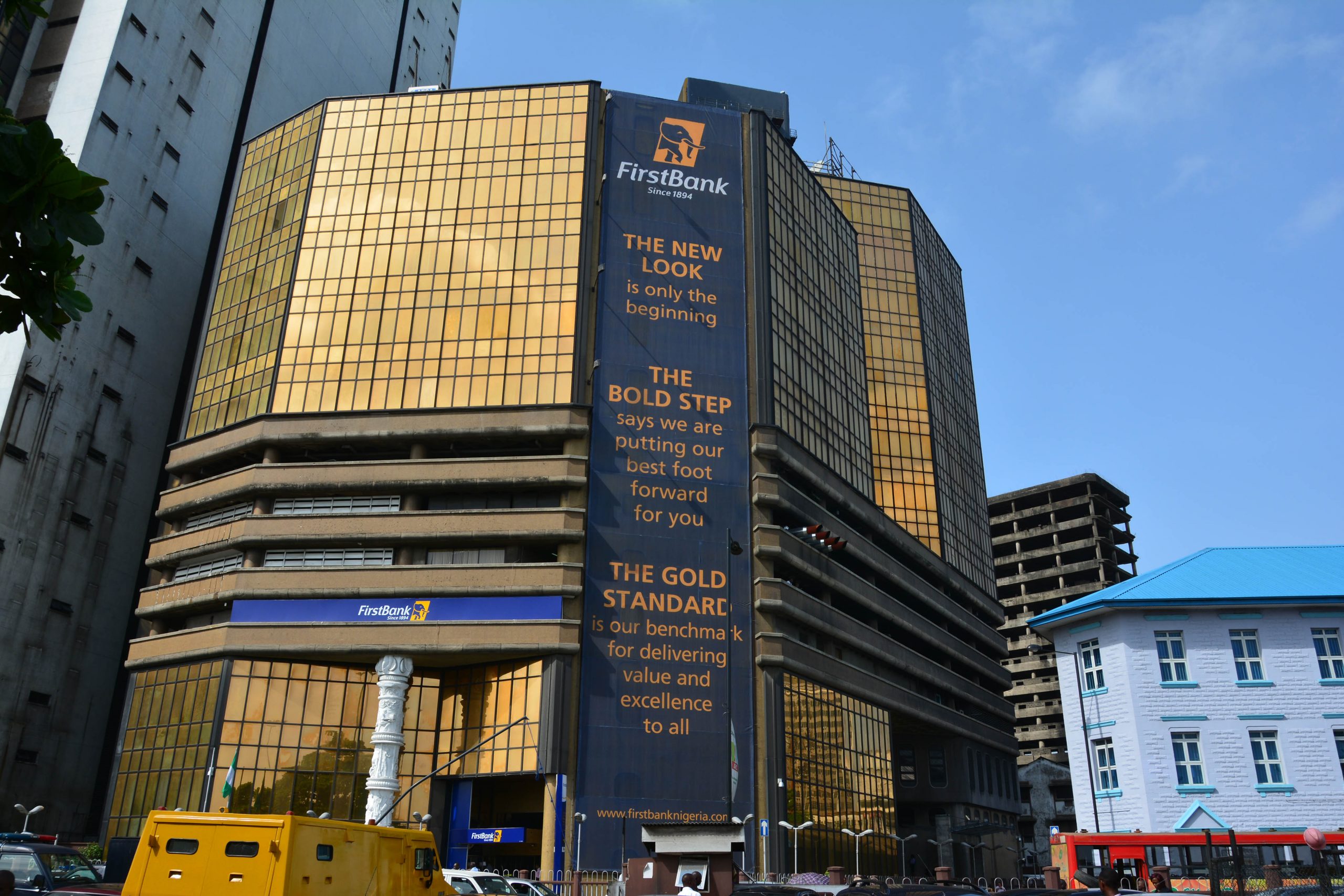
Despite the supersonic jump in its profit in 2023 financial year,FBNH only translates to less than N20 every N100 revenue made at the top line to profit to further confirm its inefficient profit machine and poor foresight of its leadership in the last two decades .
The changing fate of First Bank Nigeria ,FBN, a 129-year old corporate entity that later metamorphosed into a holding company in 2012, is not only raising deep concerns in the last two decades but questions on the quality of its leadership . This is particularly so with its incapability to reverse the status of its century-old obsolete profit engine but relying merely and mostly on its size advantage as its weapon of competition ..
In fact , the story of FBNH from grace to grass is nothing but pathetic. For some decades , FBN had been the architecture upon which the Nigerian banking industry was built ; it had achieved the proprietary position . It was the most competitive and the best run corporate entity targeted by investors as fortune mill with absolute fecundity .
Behind the investors’ and other stakeholders’ romance with this supposedly financial giant was its unrivaled brand equity, branch network and asset base . The bank is one of the too big to fail in the industry. In Nigeria.
Except for its size advantage, nothing about it is inspiring any longer . FBNH has lost the most critical strengths or beauties to its closest and far-sighted rivals as the race to the industry leadership has shifted so heavily, mostly to competence from size advantage .And for this , it has been difficult for it to reclaim its lost glory in the real sense of it, turning it now to a shadow of its former self .
The bank has been unfortunate. It has come under dilettantes , the merely intellectually curious leaders :those who are either content to live in the past, without a desire to rewrite the rules of the game ; those who enjoy orthodoxy , not inclined to build but to cut .. Those with leadership stuff that is not concerned to make the difference than making career , those not absolutely committed to staking out the future first . .
In other words, its leadership appears to be more interested in protecting the past than creating the future ,taking industry structure as a given and seldom challenge the prevailing conventions. Those were its initial challenges that gave the industry leadership to the likes of Zenith, Guaranty Trust and few others .And up till now , it has not gotten a creative leader with enough and deep foresight to turn the table round to its advantage.
Unlike FBNH,however, its challengers seem to be smarter and farsighted. They are proactively building new core competencies, pioneering new product concepts, forming new alliances, protecting nascent development programs and pursing long-term regulatory initiatives.
They make commitments to particular skill areas far ahead or in advance of the emergence of specific end product or service markets .They spend less time worrying about how to position the firm in existing competitive space but more time creating fundamentally new competitive space .
FBNH has been paying heavily for those lapses for a long time .At a point ,it was relegated to a laggard status , from tier 1 to tier 2 bank. Now , it is a financial supermarket with humongous resources that is not competitively resourceful .
FBN Holdings has had a roller coaster ride over the last two decades, surviving some disastrous loan binges that almost cost it its soul between 2011 and 2018. The swirl of corporate governance missteps over the period saw the Financial Holding Company (HoldCo) swoon between 2018 and 2020 . .Indeed, since 2016 Adeduntan, FBN’s chief executive officer (CEO) has had to steer past very turbulent financial weather as the 129-year institution recovered from large dodgy loans booked by past boards, and regulatory visits that required subtle convincing of the Central Bank of Nigeria (CBN) to grant the previously struggling money lender, forbearance.
The period between 2018 and 2020 was not just cold, but icy. The deposit money bank (DMB) saw itself punched into a squared corner, as board infighting, rising operating expenses, and fragile insider-related loan conditions created a perfect storm.
However , in the recent time ,its health and competitive has remained highly controversial. To some analysts, FBNH has greatly turned around in the last two years . Indeed, by writing down previous bad loan positions through recoveries and cutting back on operating costs. Beyond that , they believed , it has improved both its non-performing loans ratio (NPLR) and its cost-to-income ratio (CIR), Moreover , in the full year 2023 , FBNH truly grew its asset base and recorded impressive increase in its profitability. Its pretax figure which stood at N362.24 billion. This is ,no doubt, impressive as it indicated a 129% profit growth , .
. But not every analyst is comfortable with that belief . While its profit and total assets rose heavily relative to the previous year, to some analysts argued that the above figures are not enough to showcase the strength of any corporate as they do not indicate resourcefulness .Surely , no investor or analyst is comfortable with the performance without that critical value . To any of them , that is the only way to prove the return of this laggard to the champion club .
They are not wrong .FBNH has remained competitively enfeebled for over two decades mainly for its inability generate impressive values relative to its resource advantage and its industry peers ,though , it is now improving. .For instance, ts current tax profit in its 2023 is a mere ruse , a mere dummy for the gullible .
One critical criterion that exposes FBNH laggard posture is when its profitability is assessed from its profit margins perspective . For instance, in the 2023 full financial year, FBNH’s operating profit margin stands at 23.8% compared to 19.6% in 2022 .As regards its post tax profit margin , the bank had 20.4 % in 2023 ,the highest in the last ten years as against 17% in 2022 . Although these figures indicate some improvements but ,no doubt ,they are miserable when juxtaposed with its rivals .More importantly, when the best in class figures are considered no analyst could dispute this view in spite of its flamboyant absolute pretax figure in 2023 relative to 2022 .Post tax profit margin is significant as an indicator of how well it manages its costs while the operating profit margin represents how efficiently a company is able to generate profits from its core business.
In a layman language , these FBNH’s figures mean out of every N100 made at the top line ,less than N24 became the operating profit and N20.40k translated to profit after tax . What is the essence of over N1.5trillion made as the total revenue when at the end only what is retained is a paltry 20%?
In 2022 ,it was even more miserable at 16.9%. Between 2018 and 2019 , it was 6.3% and 9.9% respectively ,indicating what was translated to profit yearly was less than N10 out of the N100 made at the top line . Though , it inched up to 15.2 % and 20% respectively between 2020 and 2021, it nosedived again in 2022 to 16.9% .
Apart from its profit margins which expose its inefficient profit engine ,another one is its Return on Equity (RoE). Although as the group’s profit improved, its return on equity (RoE) glided up, rising from 2.70% in 2015 to 18.40% in FY 2021 ,however, the drop in profit in FY 2022 and the increase in shareholder funds dragged back the ROE to 14.50% .
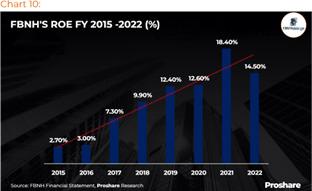
No doubt about it , the above circumstance of FBNH could be pinned down to its inefficient profit engine . This becomes more palpable when its cost to income ratios between 2019 and 2023 are considered . It rose to 66.7% in 2023 . FBNH has battled high operating costs since 2015; the lender’s cost-to-income ratio (CIR) has hovered between 55% and 70%. The group’s cost minimization strategy in 2016 knocked the CIR to 47% from 61.40% in FY 2015 but was not sustainable as the group’s CIR floated back up in 2017, rising steadily to a peak of 70% in 2019. The moderation of the HoldCo’s CIR in 2021 to 56.40% rebounded to 61.70% in FY 2022, suggesting the need for the group to keep a tighter rein on costs
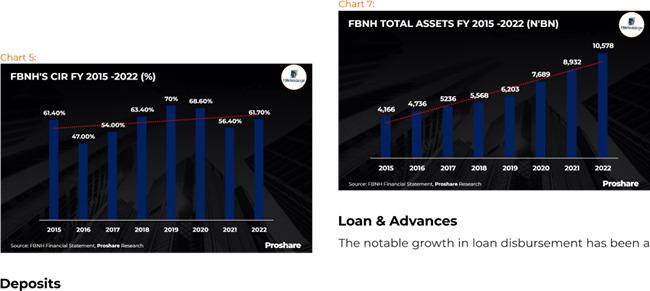
A detailed analysis of its income mix using its latest 2023 full year results confirmed the above facts as much. Whether FBNH is bench marked with its rivals or the best in class , the bank has remained consistently on a roller coaster ride over the last two decades. FBN’s financial statements and corporate performances still retain its phases of haziness, brilliance, and naivety. The leopard has not changed its spots .
2023 FINANCIAL YEAR RESULTS: NOT A DEPARTURE FROM THE PAST
The survival and success of an organization is a function of its strategic capability which is embodied in its resources and competences. Both consequently determine its ability to respond to the competing pressures or changes in the operating environment as well as cultural and political context or stakeholders’ expectations and purposes .
The above view may not be farfetched . Both its resources and competences are imperative for battling the threats in the environment , exploiting and creating opportunities , minimizing its weaknesses and optimizing its strength . First , the starting point of successful strategies is the acquisition ,retention and development of resources . No doubt about , one thing that FBNH has kept despite its loss of the industry leadership is growing its assets. Though , FBNH has lost its asset leadership ,to its rivals , a major highlight from its 2023results is the supersonic flight in the bank’s asset base. Its total assets hit N16.90 trillion in 2023 financial year from N10.58 trillion,in 2022 , an increase of +60%.
However , growing its resources without the other leg of the strategic capability which is its ability to build competences remains its basic lacuna . This is where the leadership of FBNH has not been pulling weight relative to its closest rivals . While FBNH has continued to identify opportunities in the operating environment and adapt its its resources and competences to take advantage of those opportunities , its capability to leverage such resources to achieve more from less or improve its values for money competitively has remained its biggest headache . This is still palpable in its final results for its 2023 financial year .
CORE BANKING
The core banking is where the boys are separated from the men , and lending remains its anchor as a fundamental nature of banking . The importance of lending in banking cannot , in fact , be overemphasized . Loan is ,for instance , is the highest earning asset in the balance sheet ; it contributes materially to the achievement and fulfillment of the objectives of profitability by providing higher return than other financial assets ; it helps the bank management to satisfy the legal and regulatory objectives of the monetary authorities ;‘it is a key element in the creation and maintenance of depositor relationships ,particularly with the business firms ; it is a vehicle through which management attempts to satisfy the credit needs of the community or the credit markets the bank serves or intends to serve .
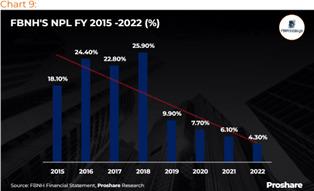
In fact, when it is said that one is a good or an astute banker ,what ,in fact , is meant is that one is a shrewd lender . –one who lends money safely and profitably .But for .FBNH it is otherwise; its laggard status is more obvious in the core banking segment of its business, neither lending profitably nor safely in the past one decade in a competitive term . In fact , the crisis that nearly led to its demise started here .This is evident in its inability to tackle the risk of mismatches between assets and liabilities and between borrowing and lending rates efficiently that was caused by its management’s poor skill in Fund transfer pricing , a method used by bankers to evaluate the profitability of deposits and loans.
Analysis of its interest income in the full year 2023 shows it is the same old story ,the same old scenario. .The group posted an interest income of N917.71 billion in FY 2023, reflecting a 66% increase from the N551.94 billion posted in FY 2022. To gain this fortune in this segment of its business , one could see the benefit of its asset size .With the bank’s total assets climbing to N16.90 trillion , an increase of +60% compared to (N10.58 trillion in the period under review , it took an advantage of this to deploy a total Loans and advances of N8.32 trillion to customers and banks . This is an increase of +66%) compared to N5.01 trillion in the corresponding period o f 2022 .
However , the size of loans deployed is not enough in a race to industry leadership . While the bank’s interest income for the year could be adjudged to be impressive relative to that of last year , its contribution to the net income ei handicapped by its less impressive savvy for managing risks and cost . How a bank manages risks and costs is expected to manifest on its net interest income that is delivered after impairment on loans is deducted .
In the period under review FBNH’s case became worse compared to the previous year . In the financial year 2023 , the amount made per N100 of interest earned backtracked to N57.80 k from N65.80k in 2022 , an indication of its weaker control of the interest rate risk .
Its situation raised more concern when its credit’s risk management worsened as Impairment charge for loan losses rose to N200,440 from N68,619 ,an increase of 192percent .Consequently , what finally came as the contribution from the core banking as its net profit after impairment charges for losses was only N36 out of N100 interest earned compared to N54 in 2022 . Between 2015 and 2018 ,the group’s non-performing loans ratios were double digits . However ,though it had crossed to single digit since 2019 and inched down to 4.30% in FY 2022, suggesting improved asset quality . But this might not be unconnected with series of write-offs in the last few years and not its leadership ‘s savvy for risk management. To save the bank from its deleterious non performing loans ratio status , its current GMD had to go to work, sleeves rolled-up, digging a trench for bad and delinquent loans and entrenching new scenario . But can the bank sustain it?
TRADING INCOME
Another income segment that usually gives bankers a tough time is trading. Banks generate trading income through trading activity in financial products such as equities (shares), bonds and derivative instruments. However trading income is the most volatile income source for a bank. It also carries relatively high market risk, as well as not inconsiderable credit risk
FBNH’s performance in the trading segment in its full year 2023 under review is highly ironical . It moved against the trend of monumental foreign exchange (FX) gains, particularly among banking majors with substantial offshore assets in 2023 and closed the year on the other side of a whooping net FX loss of over N350 billion.
The final quarter delivered N253.7 billion of the net FX losses, swelling up from N96.7 billion figure at the end of the third quarter (Q3) and a deep plunge from net FX gains of N22.4 billion at the end of 2022.
However , the bank averted a disastrous end year occurrence as the report shows that the bank’s own windfall came from net gains on financial instruments — big enough to level up the impact of the FX losses and enable a 127.6 percent lifting of the bottom line to N309.9 billion for the year.
The final quarter rolled in net gains on financial instruments of N435.2 billion, 26 times the corresponding figure of N16.8 billion in the same period in 2022 and about 64 percent of the full-year figure of N681.2 billion.
The net gains on financial instruments for the year is about 18 times the closing figure of N38.6 billion in the preceding financial year and provided the central plank for the much-elevated earnings story of FBN Holdings in 2023.
Fees and Commissions
, The only area where FBNH has been consistently reliable is the Fees and Commissions , and this advantage is bestowed on it by size and volume of transactions that is ultimately determined by its asset size .Under the period under review it raked in N171.81 billion compared to N117.97 billion, a 46% increase as its Net fee and commission income .
The edge the bank has here is not limited to the volume of transaction alone. Fee income is very popular with bank senior management because it is less volatile and not susceptible to market risk like trading income or NII. There is also no credit risk because the fees are often paid up front. There are other benefits as well, such as the opportunity to build up a diversified customer base for this additional range of services.
OPERATING INCOME VS EXPENSES
The bank’s size advantage has the other side with its humongous operating costs dwarfing its operating income and consequently boosting its cost to income ratio. In the period under review its cost to income is still on the high side 67%. This is disastrous .
ALL THE ABOVE BECAUSE OF LEADERSHIP WITH POOR FORESIGHT
What could not be disputed by anybody is that over time, new, more efficient profit engines make older engines obsolete. For this reason , only a proactive management could avert being a victim . In the case of FBNH , the leadership was ,no doubt, asleep at the switch .Its definition of served market, the value proposition put forward to customers, the margin and value-added structure, the particular configuration of assets and skills that yields those margins, and supporting administrative systems ,all of which together constitute an integral and well-tuned profit “engine of a successful firm were not constantly reviewed with the changing environment and circumstances .
The banking environment has changed dramatically . The problem is that while one profit engine may perform wondrously in one industry environment, any change to that environment typically threatens the engine’s efficiency.
The threat to FBNH”s profit engine also came from the improvements made by its competitors to some particular components of that engine. While FBNH’s competitors were redefining the boundaries of the served market , coming up with a new value proposition , discovering how to take margins out of a different part of the business system or re configuring assets and skills to produce the same value more economically, it was busy protecting its past .
The best way to ensure that one is not at risk from more imaginative competitors is to be the first to conceive of alternate value-delivery mechanisms, the first to cannibalize one’s own products and services, and the first to get to the future, even when that future undermines past successes. As Andy Groves at Intel puts it, “You have to be your own toughest competitor. but FBNH was not .”
However , like a grizzled old mechanic who bemoans the complexity of modern automobiles, an incumbent like FBNH typically has an understandable incentive to preserve the existing economic engine. At the extreme, it may be reluctant to admit to, much less proactively harness, the forces of industry transformation .The consequence of its less proactive tendency is its enfeebled competitive position .
Consequently when you peep hard into the interior workings of this bank , some big facts stare you in the face : the difficulty in less impressive loan asset quality , inadequate bank’s loan to deposit ratio (LDR), increasing the bank’s non-performing loan ratio (NPLR), inability to collaborate with fintech companies to improve the bank’s customer’s service experience and service interface , increasing cost of funding and cost of risk (CoR); and steadily increasing cost-to-income ratio (CIR have remained its major headaches for the past two decades
The reason for the above could be pinned down to a leadership with blurred vision Unlike the leadership of FBNH ,smart companies with leadership endowed with foresight are known to devote much to creating the future. They know that the new competitive realities have ruptured industry boundaries, overthrown much of standard management practice, and rendered conventional models of strategy and growth obsolete. They make commitments to particular skill areas far ahead or in advance of the emergence of specific end product markets with foresight ;they are capable of imagining products, services and the entire industries that did not yet exist and then give them a birth.
To create a future ,such leaders with the benefit of substantial and sustained intellectual energy usually develop high-quality, robust answers to certain critical questions concerning : what new core competencies they will need to build, what new product concepts should pioneer, what new alliances they need to form, what nascent development programs should be protected and what long-term regulatory initiatives should pursue; they . spend less time worrying about how to position their firms in existing competitive space and more time creating fundamentally new competitive space .
The goals of competition for industry foresight are critical and clear enough : to generate the best possible assumption base about the future and thereby develop the prescience needed to proactively shape the industry evolution, to establish one’s company as the intellectual leader in terms of influence over the direction and shape of industry transformation to give their companies potential to get to the future first and stake out a leadership position , inform corporate direction ,allow their companies to control the evolution of its industry and thereby its destiny . The trick is to see the future before it arrives.
They need foresight to answer three critical questions on what new types of customers benefits should we seek to provide in the a decade or more time ,what new competencies we will need to build or acquire to offer those benefits to customers?a ne how they will need to reconfigure the customers interface over the next several years
Consequently , a point of view about the future or foresight is a point of view about benefits, competencies and customers interface
However , if the leadership of FBNH is presumed to have foresight ,one thing that could not be disputed is that it has not been matched by execution capability.
The leadership of FBNH ,from all indications. appeared to be asleep at the switch while challengers were rewriting the rules of game . Instead , its leaders were preoccupied too much with preserving the past ; moreover ,the inability of its leadership to wake up early has turned the bank to a dinosaur of sort with competitive problems palpably wrecking havoc on its operations and threatening its survival .
This is not unusual . When there are cataclysmic climatic changes or radically altered environment,companies often find it impossible to cope with a radically altered environment. like dinosaurs threatened by cataclysmic climatic changes.
For its inability to re engineer its genetic coding periodically , FBNH has remained at the mercy of environmental upheaval as tyrannosaurus rex. Its “genetic coding, a set of biases, assumptions, and presuppositions about the structure of the relevant “industry,” about how one makes money in that industry, about who the competition is and isn’t, about who the customers are and aren’t, about what customers want or don’t want, about which technologies are viable and which aren’t, and so on was not altered to fit the changing environment or dynamics .
From the administration of Bernard Longeto the conservative and minimalist management of Moyo Ajekigbe to the aggressive and wildly transactional tenor of Bisi Onasanya to the ‘paint and repair’ era of Adesola Adeduntan, the bank has swung from one transition to another with different outcomes.
The bank’s leadership instead appeared to be more fixated with its relative size . But the starting resource positions are a very poor predictor of future industry leadership. A firm can sit atop mountains of cash and command legions of talented people, and still lose its preeminent position. Likewise, a firm can sometimes overcome enormous resource handicaps and successfully scale the heights of industry leadership. In other words , while size of a corporate entity could be critical to industry leadership , it has little significance in a digital open banking world just as it is less critical than its profitability and corporate sustainability


